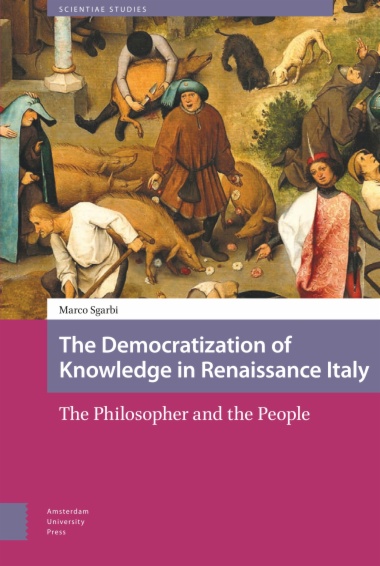The book identifies to what extent it is possible to speak of a democratization of knowledge in Renaissance Italy. It establishes the boundaries of the present investigation within the Aristotelian tradition, and outlines democratization as a process capable of assigning power to people. It deals with how the democratization of knowledge historically is invested equally in ideas from religion and philosophy, involving the same democratizers, moved by similar intentions, employing identical techniques of vulgarization and targeting equivalent communities of recipients.
- Cover
- Table of Contents
- 1. Introduction
- 2. Tug of War
- 3. Figures of Democratizers
- 4. Intentions for Democratizing
- 5. Tools of the Trade
- 6. Communities of Recipients
- 7. Epilogue
- Appendix 1
- Appendix 2
- Acknowledgements
- Bibliography
- Index
- List of Figures
- Figure 2.1: Christ as the True Light by Hans Holbein the Younger
- Figure 2.2: Robert Estienne’s Pressmark
- Figure 3.1: Frontispiece of Alessandro Piccolomini’s La seconda partede la filosofia naturale, published “alla Bottega d’Erasmo”
- Figure 4.1: Frontispiece of Brucioli’s translation of Bible, attributed to Lorenzo Lotto
- Figure 4.2: Frontispiece of Agrippa’s De occulta philosophia with the motto Nihil est opertum, quod non reveletur, & occultum quod non sciatur.
- Figure 5.1: Girolamo Catena’s Discorso sopra la traduttione delle scienze, & d’altre facultà (1581)
- Figure 6.1: Alessandro Piccolomini’s In mechanicas quaestiones Aristotelis paraphrasis (1547)
- Figure 6.2: Alessandro Piccolomini’s Parafrasi sopra le Mecaniche d’Aristotile (1582)
- Figure 6.3: Frangipane’s dedicatory letter to Giulia da Ponte, Herzog August Bibliothek Wolfenbüttel, A: 60.9 Eth.
- Figure 7.1: Vincenzo Citraedo’s Fisionomia naturale
- Figure 7.2: Giovanni Antonio Roffeni’s Discorso astrologico (1611) with the letter against Martin Hork in defense of Galileo
- Figure 8.1: Antonio Scaino’s La politica (1578)
- Figure 8.2: Antonio Brucioli’s Gli Otto libri della Repubblica (1547)
- Figure 8.3: Panfilo Persico’s Della filosofia Morale, & Politica d’Aristotele (1607)
- Figure 8.4: Galezzo Florimonte’s Ragionamenti (1567)
- Figure 8.5: Felice Figliucci’s Della filosofia morale (1551)
- Figure 8.6: Giulio Landi’s Le attioni morali (1584)
- Figure 8.7: Giulio Ballino’s La morale (1564)
- Figure 8.8: Alessandro Piccolomini L’instrumento della filosofia (1551)
- Figure 8.9: Alessandro Piccolomini’s La prima parte delle theoriche (1563)
- Figure 8.10: Bernardo Segni’s Rettorica et poetica (1549)
- Figure 8.11: Lodovico Castelvetro’s Poetica (1570)
- Figure 8.12: Angelico Buonriccio’s Paraphrasi sopra I tre libri dell’anima d’Aristotele (1565)
- Figure 8.13: Benedetto Dottori’s Trattato dei sogni (1575)
- Figure 8.14: Francesco Verino the Younger’s Trattato delle metheore (1573)

